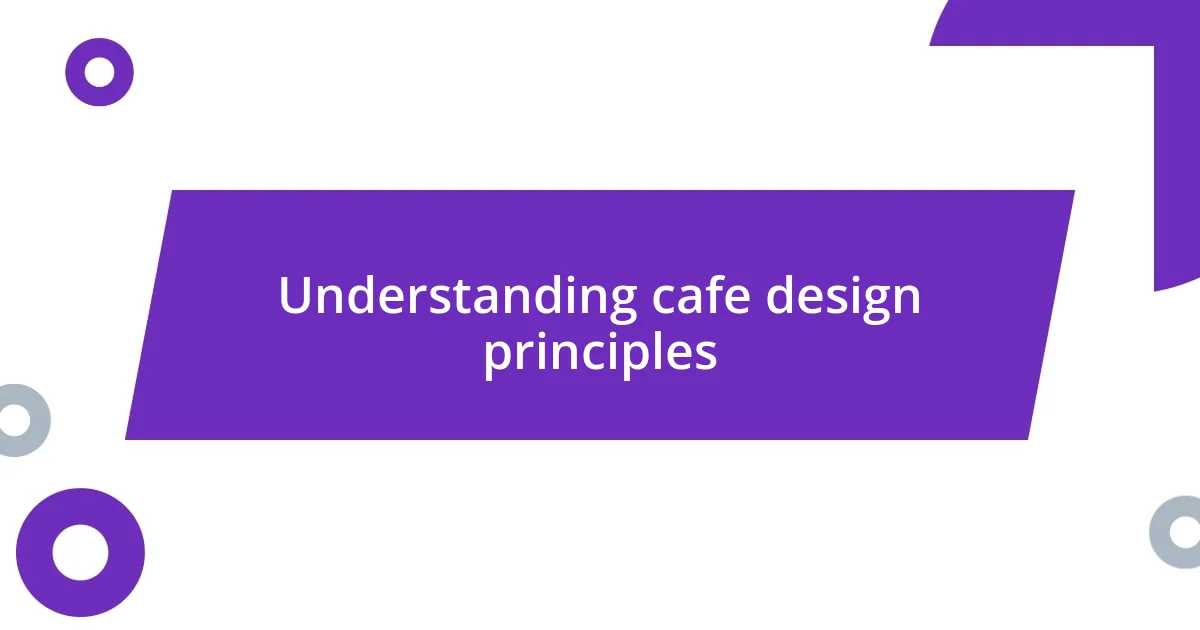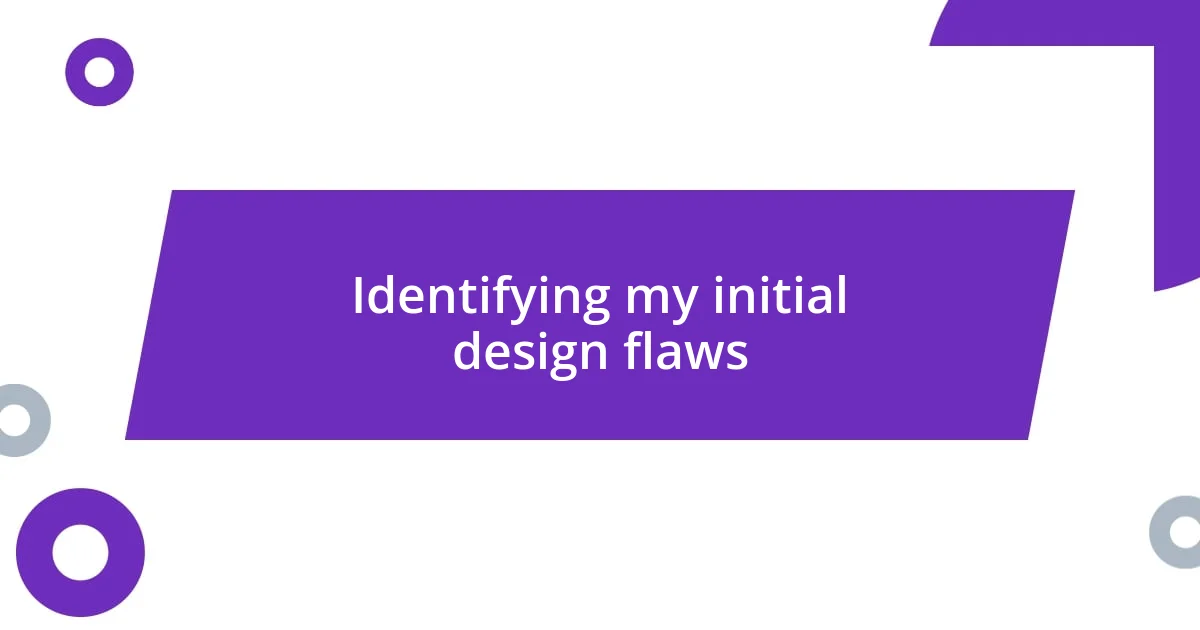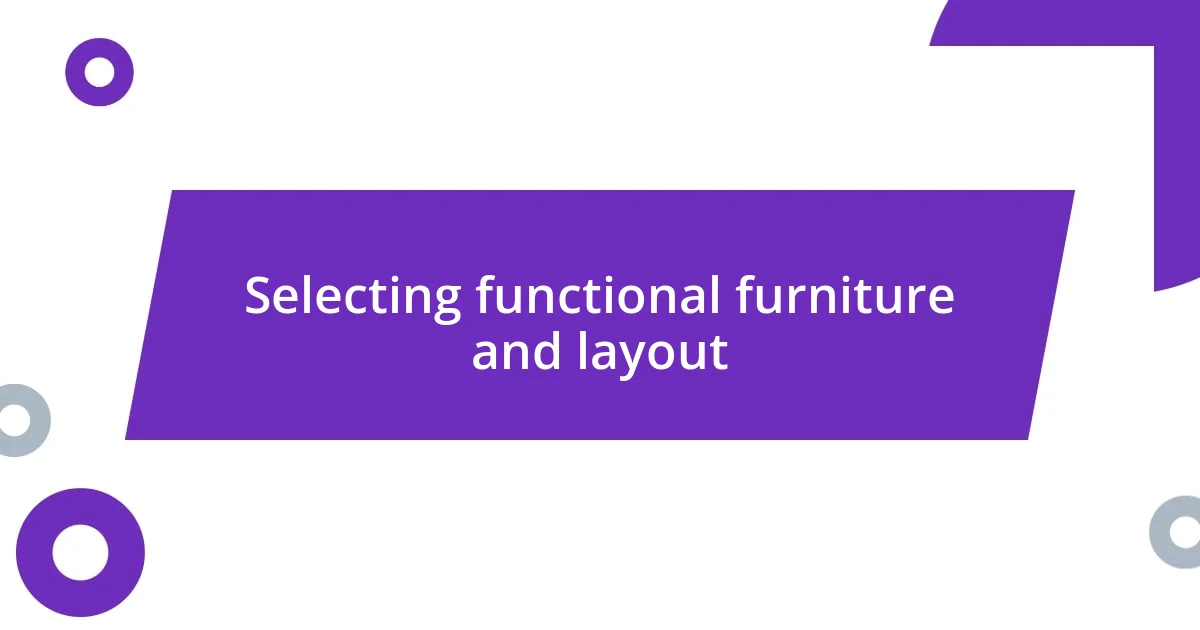Key takeaways:
- Proper café design hinges on understanding customer navigation, lighting, and color schemes to create an inviting atmosphere.
- Incorporating customer feedback led to significant improvements, enhancing customer satisfaction and transforming the café into a community hub.
- Unique decor elements and functional furniture choices fostered connections among patrons and contributed to a warm, welcoming environment.

Understanding cafe design principles
When diving into café design principles, I always feel the rush of creativity that comes from crafting an inviting atmosphere. I remember my first café; the layout was awkward, and the flow felt all wrong. I realized that understanding how people navigate a space is crucial. The placement of furniture, the width of pathways, and the overall layout can dictate whether a customer feels welcome or rushed. Have you ever walked into a café and immediately felt out of place? That’s often a design oversight.
Color plays a pivotal role in café ambiance too. I’ve experimented with various palettes and found that warm hues often evoke a sense of comfort and relaxation. Just picture a bustling café filled with soft yellows and earthy tones versus one dominated by stark whites. Which space would you want to linger in longer? Emotional responses to color can significantly impact how customers perceive their experience, transforming a simple coffee run into a cozy retreat.
Lighting is another principle that can’t be overlooked. I once dimmed the lights too much during the evening hours, thinking it would create a cozy vibe, but it ended up making people uncomfortable. I learned that balancing natural light with softer artificial sources enhances the experience. By adjusting the lighting throughout the day, I’ve noticed how it changes the energy of the café, inviting people to relax or gather for conversations, ultimately making it a space that reflects a multitude of moods. Isn’t it fascinating how intentional design choices can transform a mere café into a memorable destination?

Identifying my initial design flaws
Identifying my initial design flaws was truly an eye-opening experience. I remember standing in my café, observing customers navigate the space with puzzled expressions. It hit me that some of my decisions, like the placement of the counter too close to the entrance, created unnecessary congestion. These small miscalculations affected not just the flow, but also the overall atmosphere, making it less inviting than I had envisioned.
Here are some design flaws I identified early on:
- Counter placement: Positioned too close to the entrance, causing congestion.
- Seating arrangement: Tables were too clustered, making it hard for larger groups to find space.
- Color choices: Initially painted the walls in a cool blue, which didn’t evoke the warmth I intended.
- Insufficient lighting: Certain corners felt dark and unwelcoming, detracting from a cozy vibe.

Incorporating customer feedback for improvement
Incorporating customer feedback has been a game changer for my café design. I vividly recall a day when a regular customer suggested adding more outlets for laptops. At first, I hadn’t considered it essential, but I reflected on their comment. After implementing the changes, I noticed an uptick in customers lingering longer, which not only boosted sales but also transformed the café into a community hub. Hasn’t that made me realize that sometimes the smallest adjustments can lead to the biggest impact?
I started actively seeking feedback through simple comment cards and casual conversations. One memorable instance was when a mother expressed her concerns about the noise levels during busy mornings. Her feedback led me to create a quieter area, which has since become a favorite among those looking to escape the chaos. Listening to my patrons revealed insights that I wouldn’t have otherwise discovered. This ongoing dialogue with customers is invaluable; it makes them feel valued while guiding my design choices.
To put this into perspective, I began documenting feedback trends and their outcomes. After analyzing suggestions, I categorized adjustments made based on customer responses:
| Feedback Type | Change Made |
|---|---|
| More Power Outlets | Added outlets at tables |
| Noise Concerns | Created a quieter space |
Observing the positive changes in customer satisfaction has been rewarding, and it’s a continuous journey of evolution driven by those who matter most—my customers.

Choosing the right color scheme
Choosing the right color scheme was one of the most transformative steps in evolving my café design. Initially, I opted for a cool blue that seemed trendy, but it quickly felt sterile, lacking the warmth I wanted. I still remember the moment I switched to warm earthy tones; as I painted, I could almost feel the atmosphere shift, inviting a sense of comfort that made my heart swell with excitement.
As I explored different color palettes, I paid close attention to how colors can evoke feelings. For instance, I sampled a soft terracotta and rich olive green that not only complemented each other beautifully but also encouraged a calm, relaxed vibe. I still reflect on how the changes impacted the customers’ responses—more smiles, longer conversations. Hasn’t it been said that color can influence mood? Seeing it in action reaffirmed my belief in the power of thoughtful design.
What’s fascinating to me is that different colors can invoke different associations. While blue often brings tranquility, orange can spark creativity and conversation. I vividly recall a group of artists who set up their easels in my café, inspired by the burst of vibrant color I had introduced. It became a space for creativity, a hub where ideas flowed as freely as the coffee. Choosing the right colors turned the café from a mere stop into a welcoming retreat for anyone seeking inspiration.

Selecting functional furniture and layout
Selecting the right furniture and layout has been an adventure in balancing aesthetics with functionality. I remember the first time I experimented with communal tables. Initially, I hesitated, thinking they might not fit my café’s vibe. However, after introducing several large, rustic tables, I noticed an immediate transformation in how customers interacted. They began sharing stories over lattes and forming connections, turning my café into a place of community. Isn’t it remarkable how furniture choices can actually foster relationships?
I also discovered that the arrangement of furniture plays a critical role in customer flow. During one particularly bustling morning, I observed that the narrow aisles were becoming congested, leading to frustrated patrons. I decided to reconfigure the seating to create more elbow room, ensuring easy navigation without disrupting the cozy atmosphere. This small tweak not only reduced stress for my customers but increased overall satisfaction – a perfect example of how thoughtful layout can enhance the experience.
When considering furniture selections, I always focus on durability and comfort. Investing in quality chairs made of robust materials was a game-changer; they not only held up beautifully but also invited people to linger. I recall one rainy afternoon when a couple nestled into plush armchairs by the window, lost in conversation and laughter for hours. Watching them enjoy that moment made me realize that functional furniture can create lasting memories, turning a simple café visit into a cherished outing.

Adding unique decor elements
Integrating unique decor elements into my café design was like adding vibrant brushstrokes to a blank canvas. I can still picture the day I hung mismatched vintage mirrors on a wall. Each mirror told its own story, reflecting not just the space but the eclectic spirit of my café. It sparked conversations among customers who began to share their own experiences about similar decor in their homes. Hasn’t something simple like a mirror turned out to be a conversation starter before?
I also explored local artistry by showcasing handcrafted pieces from nearby artists. I recall the time I displayed a series of hand-painted tiles that not only enhanced the aesthetics but also highlighted local culture. Guests would often admire the craftsmanship, and I felt a sense of pride, knowing that my cafe was a platform for creativity. It’s incredible how unique decor can breathe life into a space and make it resonate with both locals and visitors alike—how often can a few tiles forge a connection to a community?
Incorporating seasonal décor has become another personal favorite of mine. I remember decorating with autumn leaves and mini pumpkins during November, instantly transforming the atmosphere. Customers commented on how warm and inviting the café felt, and I found myself delighted to see families gathering to enjoy hot cider amidst the festive decor. Those seasonal touches remind me that a café is not just a place for coffee; it’s a living, breathing space that evolves, inviting customers to experience the changing seasons in a tangible way. Isn’t it wonderful how decor can amplify a sense of place and time?














